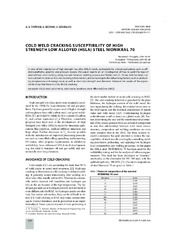Приказ основних података о документу
Cold weld cracking susceptibility of high strength low alloyed (hsla) steel nionikral 70
| dc.creator | Tawengi, A. S. | |
| dc.creator | Sedmak, Aleksandar | |
| dc.creator | Grabulov, Vencislav | |
| dc.date.accessioned | 2022-09-19T17:34:21Z | |
| dc.date.available | 2022-09-19T17:34:21Z | |
| dc.date.issued | 2014 | |
| dc.identifier.issn | 0543-5846 | |
| dc.identifier.uri | https://machinery.mas.bg.ac.rs/handle/123456789/2037 | |
| dc.description.abstract | In view of the importance of high strength low alloy (HSLA) steels, particularly for critical applications such as offshore platforms, pipeline and pressure vessels, this paper reports on an investigation of how to weld this type of steel without cold cracking. Using manual metal arc welding process and Tekken test (Y - Grove test) has been caned Out both to observe the cold cracking phenomenon, and to investigate the influencing factors, such as preheating temperature and energy input, as well as electrode strength and diameter. However the result of the experiments show that there is a risk of cold cracking. | en |
| dc.publisher | Faculty of Metallurgy | |
| dc.relation | info:eu-repo/grantAgreement/MESTD/Basic Research (BR or ON)/174004/RS// | |
| dc.relation | info:eu-repo/grantAgreement/MESTD/Technological Development (TD or TR)/35002/RS// | |
| dc.rights | openAccess | |
| dc.rights.uri | https://creativecommons.org/licenses/by/4.0/ | |
| dc.source | Metalurgija | |
| dc.subject | weld metal | en |
| dc.subject | HSLA steel | en |
| dc.subject | Heat Affected Zone (HAZ) | en |
| dc.subject | hardness | en |
| dc.subject | cold cracks | en |
| dc.title | Cold weld cracking susceptibility of high strength low alloyed (hsla) steel nionikral 70 | en |
| dc.type | contributionToPeriodical | |
| dc.rights.license | BY | |
| dc.citation.epage | 626 | |
| dc.citation.issue | 4 | |
| dc.citation.other | 53(4): 624-626 | |
| dc.citation.rank | M22 | |
| dc.citation.spage | 624 | |
| dc.citation.volume | 53 | |
| dc.identifier.fulltext | http://machinery.mas.bg.ac.rs/bitstream/id/826/2034.pdf | |
| dc.identifier.rcub | https://hdl.handle.net/21.15107/rcub_machinery_2037 | |
| dc.identifier.scopus | 2-s2.0-84900988450 | |
| dc.identifier.wos | 000335807600051 | |
| dc.type.version | publishedVersion |


